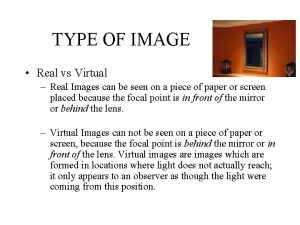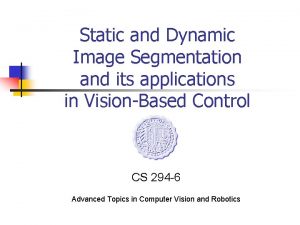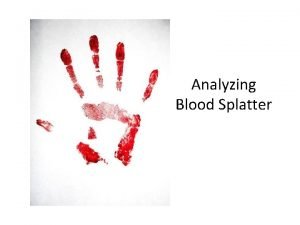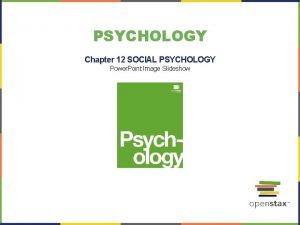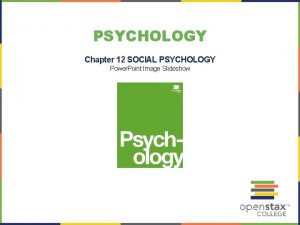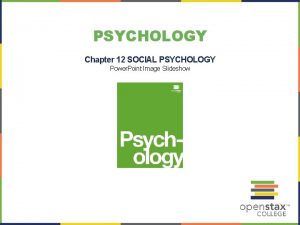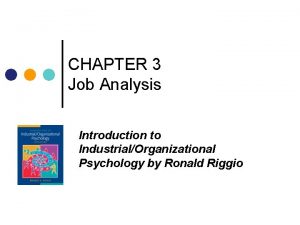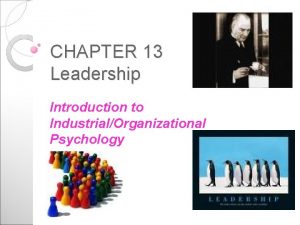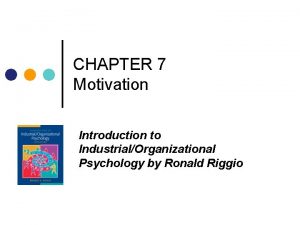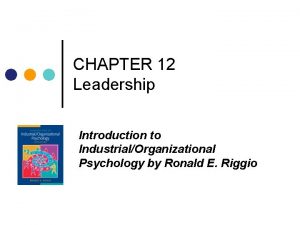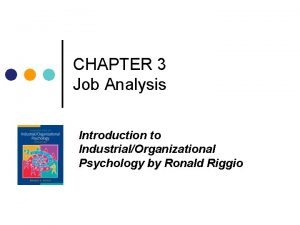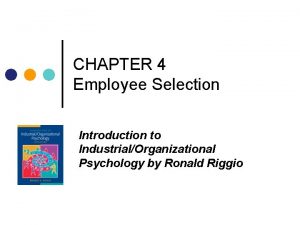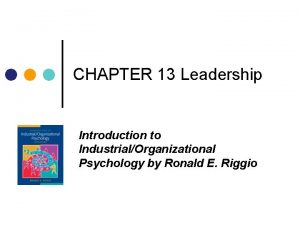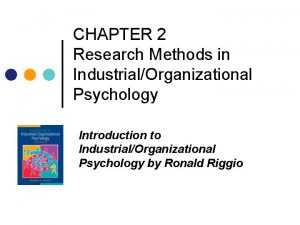PSYCHOLOGY Chapter 13 INDUSTRIALORGANIZATIONAL PSYCHOLOGY Power Point Image















- Slides: 15

PSYCHOLOGY Chapter 13 INDUSTRIAL-ORGANIZATIONAL PSYCHOLOGY Power. Point Image Slideshow

FIGURE 13. 1 What does an office look like? For people who telecommute, their workspace may be adapted to fit their lifestyle. (credit: “left”: modification of work by Cory Zanker; credit “center”: modification of work by “@Saigon”/Flickr; credit “right”: modification of work by Daniel Lobo) This Open. Stax ancillary resource is © Rice University under a CC-BY 4. 0 International license; it may be reproduced or modified but must be attributed to Open. Stax, Rice University and any changes must be noted. Any images credited to other sources are similarly available for reproduction, but must be attributed to their sources.

FIGURE 13. 2 (a) Industrial psychology focuses on hiring and maintaining employees. (b) Organizational psychology is interested in employee relationships and organizational culture. (credit a: modification of work by Cory Zanker; credit b: modification of work by Vitor Lima) This Open. Stax ancillary resource is © Rice University under a CC-BY 4. 0 International license; it may be reproduced or modified but must be attributed to Open. Stax, Rice University and any changes must be noted. Any images credited to other sources are similarly available for reproduction, but must be attributed to their sources.

FIGURE 13. 3 Human factors psychology is the study of interactions between humans, tools, and work systems. This Open. Stax ancillary resource is © Rice University under a CC-BY 4. 0 International license; it may be reproduced or modified but must be attributed to Open. Stax, Rice University and any changes must be noted. Any images credited to other sources are similarly available for reproduction, but must be attributed to their sources.

FIGURE 13. 4 Hawthorne Works provided the setting for several early I-O studies. This Open. Stax ancillary resource is © Rice University under a CC-BY 4. 0 International license; it may be reproduced or modified but must be attributed to Open. Stax, Rice University and any changes must be noted. Any images credited to other sources are similarly available for reproduction, but must be attributed to their sources.

FIGURE 13. 5 Researchers discovered that employees performed better when researchers or supervisors observed and interacted with them, a dynamic termed the Hawthorne effect. This Open. Stax ancillary resource is © Rice University under a CC-BY 4. 0 International license; it may be reproduced or modified but must be attributed to Open. Stax, Rice University and any changes must be noted. Any images credited to other sources are similarly available for reproduction, but must be attributed to their sources.

FIGURE 13. 6 (a) Frederick Taylor (1911) strived to engineer workplaces to increase productivity, based on the ideas he set forth in (b) his book, The Principles of Scientific Management. (c) Taylor designed this steam hammer at the Midvale Steel Company. (credit c: modification of work by “Kheel Center, Cornell University”/Flickr) This Open. Stax ancillary resource is © Rice University under a CC-BY 4. 0 International license; it may be reproduced or modified but must be attributed to Open. Stax, Rice University and any changes must be noted. Any images credited to other sources are similarly available for reproduction, but must be attributed to their sources.

FIGURE 13. 7 (a) Lillian Gilbreth studied efficiency improvements that were applicable in the workplace, home, and other areas. She is credited with the idea of (b) putting shelves on the inside of refrigerator doors and (c) foot-pedal-operated garbage cans. (credit b: modification of work by “Goedeker’s”/Flickr; credit c: modification of work by Kerry Ceszyk) This Open. Stax ancillary resource is © Rice University under a CC-BY 4. 0 International license; it may be reproduced or modified but must be attributed to Open. Stax, Rice University and any changes must be noted. Any images credited to other sources are similarly available for reproduction, but must be attributed to their sources.

FIGURE 13. 8 Training usually begins with an orientation period during which a new employee learns about company policies, practices, and culture. (credit: Cory Zanker) This Open. Stax ancillary resource is © Rice University under a CC-BY 4. 0 International license; it may be reproduced or modified but must be attributed to Open. Stax, Rice University and any changes must be noted. Any images credited to other sources are similarly available for reproduction, but must be attributed to their sources.

FIGURE 13. 9 In a 360 -degree performance appraisal, supervisors, customers, direct reports, peers, and the employee himself rate an employee’s performance. This Open. Stax ancillary resource is © Rice University under a CC-BY 4. 0 International license; it may be reproduced or modified but must be attributed to Open. Stax, Rice University and any changes must be noted. Any images credited to other sources are similarly available for reproduction, but must be attributed to their sources.

FIGURE 13. 10 (a) Pregnancy, (b) religion, and (c) age are some of the criteria on which hiring decisions cannot legally be made. (credit a: modification of work by Sean Mc. Grath; credit b: modification of work by Ze’ev Barkan; credit c: modification of work by David Hodgson) This Open. Stax ancillary resource is © Rice University under a CC-BY 4. 0 International license; it may be reproduced or modified but must be attributed to Open. Stax, Rice University and any changes must be noted. Any images credited to other sources are similarly available for reproduction, but must be attributed to their sources.

FIGURE 13. 11 The laws shown here protect employees in the U. S. from discriminatory practices. This Open. Stax ancillary resource is © Rice University under a CC-BY 4. 0 International license; it may be reproduced or modified but must be attributed to Open. Stax, Rice University and any changes must be noted. Any images credited to other sources are similarly available for reproduction, but must be attributed to their sources.

FIGURE 13. 12 Hooters restaurants only hire female wait staff. (credit: “Bem. Loira Bem. Davassa”/Flickr) This Open. Stax ancillary resource is © Rice University under a CC-BY 4. 0 International license; it may be reproduced or modified but must be attributed to Open. Stax, Rice University and any changes must be noted. Any images credited to other sources are similarly available for reproduction, but must be attributed to their sources.

FIGURE 13. 13 When companies are combined through a merger (or acquisition), there are often cuts due to duplication of core functions, like sales and accounting, at each company. This Open. Stax ancillary resource is © Rice University under a CC-BY 4. 0 International license; it may be reproduced or modified but must be attributed to Open. Stax, Rice University and any changes must be noted. Any images credited to other sources are similarly available for reproduction, but must be attributed to their sources.

FIGURE 13. 14 Checklists, such as the WHO surgical checklist shown here, help reduce workplace accidents. This Open. Stax ancillary resource is © Rice University under a CC-BY 4. 0 International license; it may be reproduced or modified but must be attributed to Open. Stax, Rice University and any changes must be noted. Any images credited to other sources are similarly available for reproduction, but must be attributed to their sources.
 Power trianlge
Power trianlge Power bi training powerpoint
Power bi training powerpoint Point point power
Point point power Group polarization vs groupthink
Group polarization vs groupthink Real vs virtual image
Real vs virtual image Virtual and real images
Virtual and real images Translate
Translate Optimum notch filter in digital image processing
Optimum notch filter in digital image processing Spatial and temporal redundancy in digital image processing
Spatial and temporal redundancy in digital image processing Key stages in digital image processing
Key stages in digital image processing Analog image and digital image
Analog image and digital image Lossless image compression matlab source code
Lossless image compression matlab source code Image sharpening in digital image processing
Image sharpening in digital image processing Motion segmentation
Motion segmentation Geometric transformation in digital image processing
Geometric transformation in digital image processing Area of convergence
Area of convergence




